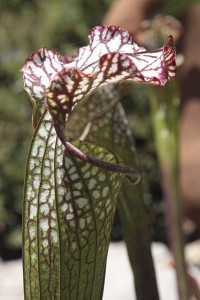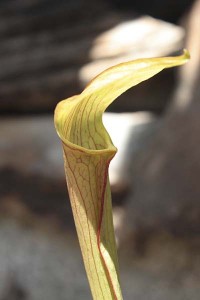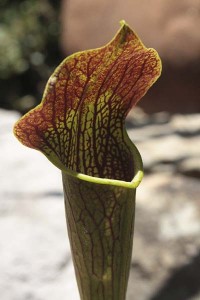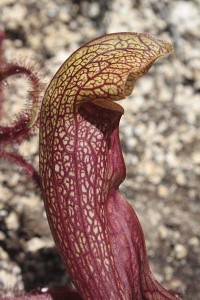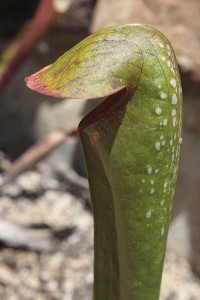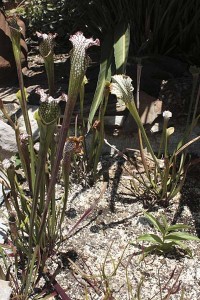Here are some of the pitcher plants growing in my guilty pleasure bog garden, a small concrete container in which I have more than a half dozen of these sarracenias and as many sundews. The guilty pleasure part of this comes in when you consider that most of California is now in its third year of drought, and when you realize that none of the plants in the bog garden likes to dry out. And preferably they’d like to have their toes, though not all their roots, in standing water.
The genus Sarracenia is native mostly to wet zones in the Eastern and Southern United States (with one species into Canada). The ones I’ve tried are proving to be pretty easy to grow as long as they get sunlight and good-quality water. (I’ve probably mentioned before how mine get reverse osmosis water from the local water cafe instead of the hyperchlorinated bong water that comes out of most Southern California spigots. So far, providing good water has been the most difficult part of growing these plants.)
These plants, left to right, top to bottom:
- Sarracenia rubra
- S. leucophylla ‘Tarnok’
- S. x Dixie Lace
- S. alata
- S. minor
There’s also a closely related swamp thing that’s native to Northern California and Oregon. That plant, Darlingtonia californica, however, is as difficult to grow in most locations as it is stunning. If your can’t provide summer night temperatures below 55 degrees, don’t bother with it. You’ll kill it. I killed mine. Not all native plants makes sense to grow if they’re not native to your environment! (If you really must do what I did and not as I say, you could try constructing a special darlingtonia box like they do in Japan to lower temperatures around the plant.)
So what’s the water use? During the hottest months the little bog survives on three to four 5-gallon servings a month of water. That totals around 15-20 gallons for a space that’s about six or seven square feet, or about 2.1 to 3.3 gallons per square foot. I was a little shocked when I compared this number to what one source says it takes to maintain a typical lawn over the summer here in the coastal zone: 2.6-3.6 gallons per square foot.
Like, I can have a tiny little swamp garden for about the same amount of water it takes to support an equivalent spot of average lawn? And when you consider that most lawns are larger than six or seven square feet, I suddenly feel a little less guilty about my little guilty pleasure. And it made me look at lawns differently, that they’re just green swamps full of grass. I think I’d rather have my little bog garden.
(Full disclosure: We still do have a small patch of grass in the backyard which gets greened up for the big Fourth-of-July party and then neglected most of the rest of the year. It helps to have heavy afternoon shade like we do to minimize how much water a lawn requires. But when the guy who keeps it mowed and edged won’t do it any more (you know who you are), the lawn is history…)

